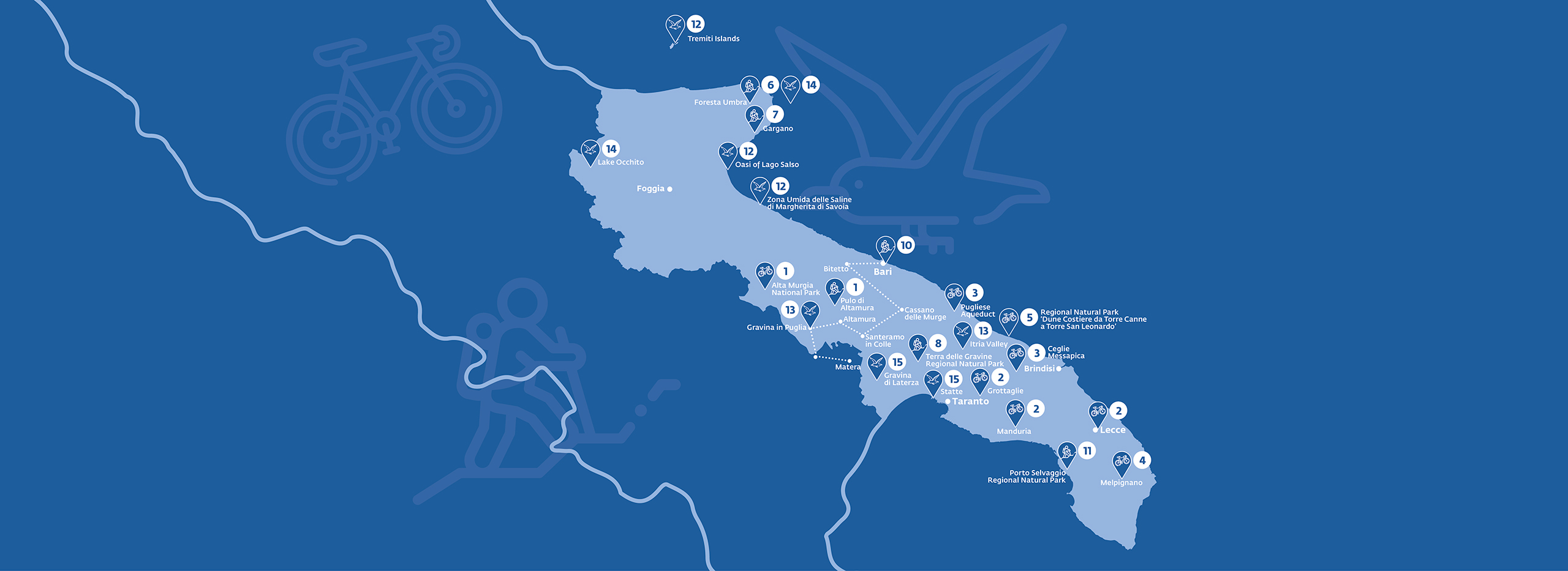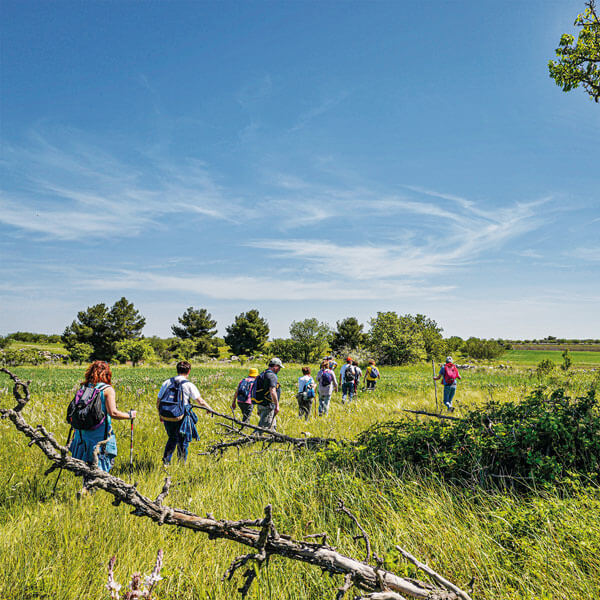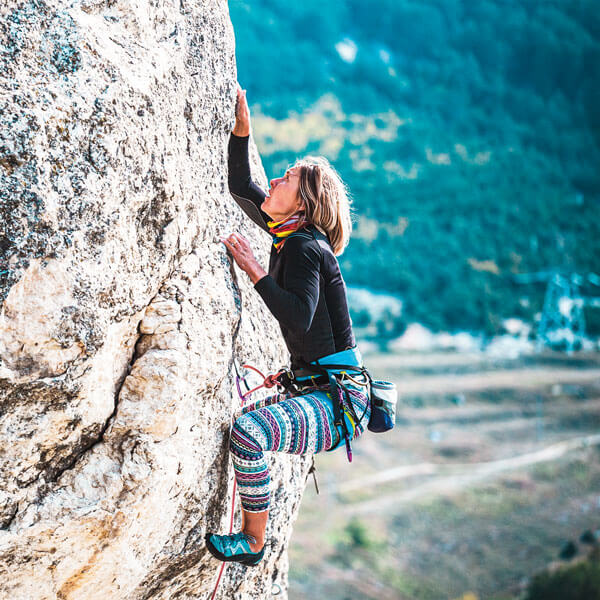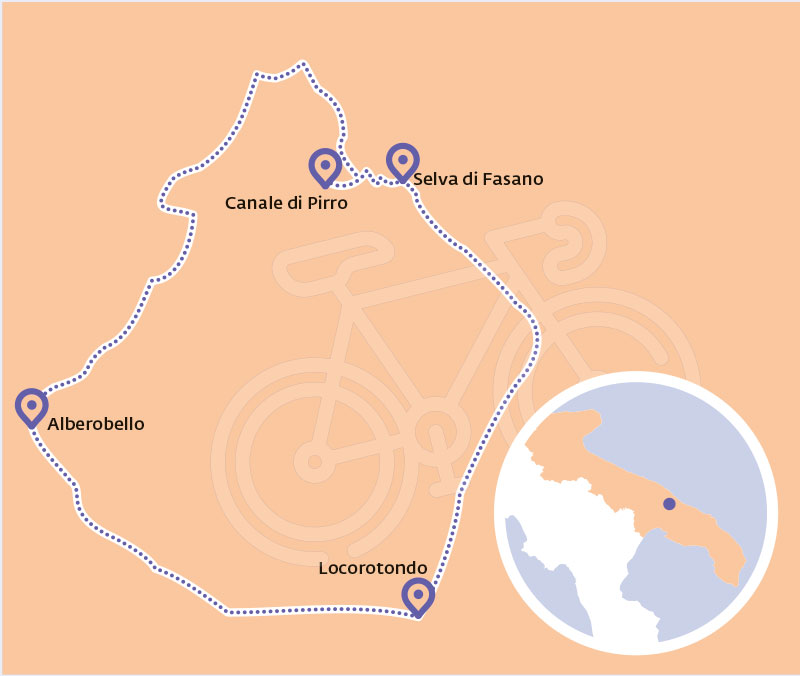
The gentle slopes and sweeping highlands of the Alta Murgia National Park set an epic stage for cycling. Routes snake across the harsh landscape whose look changes with the seasons: green and lush in spring, parched golden yellow in summer. Wild vegetation and pockets of oak and conifer woods patch the highlands which are dotted with medieval castles and ancient farms, some of which now offer accommodation for weary cyclists. You can join guided rides led by experienced local cyclists or go it alone.
Fuel your pedalling with a taste of Puglia’s best-known wines on a tour of the sun-baked hinterland between Grottaglie and Lecce. The route takes in historic towns and flamboyant baroque architecture as well as endless vineyards around Manduria, capital of Puglia’s prized Primitivo wine. Further east, Primitivo gives way to Negroamaro, a grape used to produce dark, robust reds. This 97 km trail is one of 12 long-distance routes that traverse the region following old pilgrim routes, ancient paths and quiet country roads. For further information see.
Puglia’s longest cycle route follows the 500km-long Pugliese Aqueduct, built in the first half of the 20th century to transport water from the neighbouring Campania region to Santa Maria di Leuca at the tip of the Salento. The route is divided into several legs, one of which traverses the Itria Valley from Figazzano to Ceglie Messapica. Running for just over 10 km, this short stretch immerses you in the area’s bucolic scenery leading along drystone walls, past vineyards and never-ending olive groves speckled with pointy trulli.
Discover the Salento’s Greek roots on a ride through the area’s hinterland. South of Lecce, you can still hear people speak a neo-Greek dialect known as grecanico or griko, which harks back to the Byzantine culture that once held sway here. Organised cycle tours take you deep into the territory, highlighting many of its fascinating features: stone quarries, centuries-old masserie, olive groves, abandoned Byzantine villages, historic water wells and mysterious menhirs.
In the heart of Regional Natural Park “Dune Costiere da Torre Canne a Torre San Leonardo”, the park’s main visitor centre has been transformed into a ‘Bike Hotel’ where you can hire bikes and join guided rides. Cycle routes showcase the park’s highlights or concentrate on specific themes such as extra-virgin olive oil or masserie farmhouses. Pedal out on one of these and you’ll come across a stretch of the ancient Via Traiana, a Roman road that once connected Rome and Brindisi, as well as thousand-year old olive trees and an underground cave mill complete with an intact olive oil press.

Extending for 15,000 hectares, the Foresta Umbra, listed among UNESCO Primeval Beech Forests, is the green heart of the Gargano National Park, and a great spot for walkers. Some 15 waymarked trails lead through the park’s wild vegetation and ancient beech woods. Paths take you deep into the thickets that carpet the 832m-high Mt Iacotenente and Mt Barone, as well as the Bosco Quarto, a woodland renowned for its towering Turkey oaks. You can stop off at the small Otri and Umbra lakes, and the Sfilzi Refuge with its historic fountain. Before hitting the trail, check in at the forest’s visitor centre to grab a map, or hook up with a local guide.
The Gargano Running and Trekking Park has 160 km of trails, many following ancient tracks used by pilgrims and shepherds. Three stand out. The first is the spectacular trek up the 874m-high Mt Sacro. The route is beautiful between February and September when the wild orchids are out. A second, the Saracen Trail, runs from the centre of Mattinata to the Dauna necropolis on Mt Saraceno where you’ll find 500 tombs carved into the rock. A third leads 21 km from Mattinata to four of the Gargano’s best beaches: Mattinata, Mattinatella, Baia delle Zagare and Vignanotica.
The gorges that riddle the limestone landscape of the Murgia are best explored on foot. These canyons were lived in for centuries, and guided walks take you into their depths to discover the ancient cave dwellings and churches that honeycomb the rock. For the most dramatic scenery, head to Ginosa, Massafra, Gravina in Puglia and Laterza, whose ravine is reckoned to be the largest in Europe. Since 2005 much of Puglia’s canyon country has been protected as part of the Terra delle Gravine Regional Natural Park.
Take to the wild expanses of the Alta Murgia National Park. A network of trails crisscrosses the park’s 68,000 hectares, running past centuries-old farmhouses to landmarks such as the Pulo di Altamura, a vast crater-shaped sinkhole that plunges to a depth of 92 m. A 40-minute drive away, there’s further walking in the Mercadante Forest, located for the most part in the municipality of Cassano. Planted in the 1930s to counteract soil erosion, the 1300-hectare forest is today laid out with paths and picnic areas.
From the mighty Basilica of San Nicola in Bari to the UNESCO-listed sassi of Matera in neighbouring Basilicata, this trail cuts a swathe through the ancient land of Peucetia. The ever-changing landscape is a real highlight, encompassing lush olive groves, oak forests, rugged ravines and the steppes of the Murgia plateau. The whole route is 170 km but you can easily break it down into more manageable day-long stretches. For more details on this and other long-distance routes, many of which follow the medieval Via Francigena pilgrim route and the Cammino Materano, check out www.viaggiareinpuglia.it/idee-di-viaggio/en.

Boasting 300 hectares of pine groves and around 7 km of rocky, unspoiled coastline, the Porto Selvaggio Regional Natural Park offers some wonderful, easy-going walking. Paths, some of which can be slippery, lead to the Grotta del Cavallo, a limestone cave where archaeologists have unearthed a series of prehistoric artefacts. As you walk, make sure to have a camera to hand to capture the lovely coastal scenery and seascapes from the 16th-century Torre dell’Alto.

Encompassing 1040 hectares of coastal wetlands near Manfredonia, the WWF Oasis of Lago Salso offers superb birdwatching. It provides a habitat for more than 200 species of birds throughout the year, ranging from ducks and small swamp birds to herons, storks and larger birds of prey such as falcons, harriers and ospreys. For information about the local flora and fauna and the paths that traverse the area, stop by the visitor centre on the SP141 road. About 30 km southwest of the Oasis, the Zona Umida delle Saline di Margherita di Savoia is another prime spot for twitchers. Europe’s most extensive salt flats play host to a long list of birds including Italy’s largest colony of pink flamingoes and the curlew, a wader at serious risk of extinction. Off-shore, shearwaters are among the many migratory birds you’ll find soaring over the Tremiti Islands.
For an unforgettable birds-eye view over Puglia, take to its skies in a hot air balloon. Flights, which depart shortly after dawn and generally last about an hour, cover four main areas, each showcasing a particular terrain. There are the spectacular canyons and rocky gorges of the Terra delle Gravine Regional Natural Park. Then, to the north, the ancient town of Gravina in Puglia provides an unforgettable spectacle on the southern edge of the Alta Murgia National Park. Further northwards, you can float over Castel del Monte and admire the mysterious octagonal form of Puglia’s most celebrated castle. Yet more architectural eccentricities await in the Itria Valley in the form of the Hobbit-like trulli houses. These ancient abodes lie scattered across the landscape, dotted around the Valley’s white towns, vineyards and olive groves.
A patchwork of pastures, lakes, green hills and woods roamed by wolves, the northern Daunia is perfect for horse riding. On the regional border with Molise, Lake Occhito provides the pretty backdrop to a 13km-ride from Carlantino to the Ponte dei Tredici Archi. Atop your steed you’ll cross woods of poplars and willow trees, and pass waters in which otters and sea birds happily splash. In the Gargano, you can saddle up in the Umbra Forest and explore ancient woodlands around the Sfilzi Refuge, as well as take lessons with qualified instructors. Also in the province of Foggia, a number of masserie offer excursions on horseback.
Puglia is considered one of Italy’s flatter regions but with stretches of plummeting cliffs and plenty of rocky ravines, it boasts some surprisingly good rock climbing. One of the best spots is the Gravina di Laterza, which has 22 recognised routes catering to all levels. Near Taranto, the cliffs of Statte are another popular site, attracting free-climbers from across Europe and offering wonderful scenery.

Immerse yourself in the rustic scenery of the Itria Valley on this 34 km route starting and ending in Alberobello. Once you’ve had a look around the UNESCO-listed trulli that huddle together on Alberobello’s winding streets, hit the road and head out of town. Follow the panoramic Canale di Pirro, a valley which looks down towards Fasano, Savelletri, Torre Canne and Pezze di Greco. The countryside here is typical of the area with vines and gnarled olive trees writhing up from rusty-red fields enclosed by grey drystone walls. All the while, the sea beckons on the blue horizon. The route leads on to the Selva di Fasano, a woody hill covered with oaks, pines, chestnut and cypress trees. Check out the 17th-century Chiesetta della Madonna del Carmelo and the Trullo del Signore, a modern church designed with a typical trullo conical roof. Then start back through the Itria Valley to Locorotondo, a picturesque white town known for its cummerse (tall houses with sloping roofs) and crisp white wine. From here it’s a straightforward 9 km or so back to Alberobello, where you can overnight in a trullo B&B.


BuyPuglia is the digital system tailored to suit your tourism business in Puglia. Our matching platform is an easy tool to explore meeting opportunities with Puglian suppliers and learn about their tourism &.. cultural products. BuyPuglia ranks buyers and sellers based on entered information. Shared interests are paired, helping plan effective meetings and delivering optimized supply &.. demand solutions.